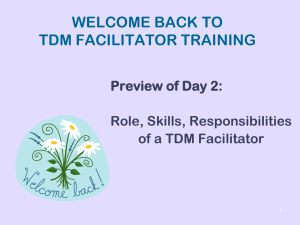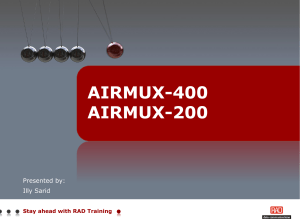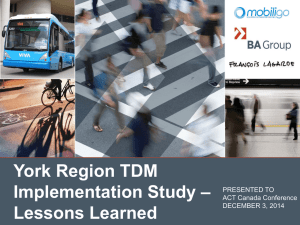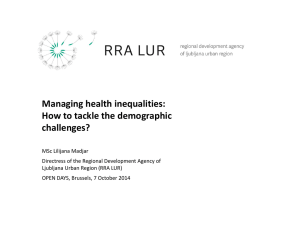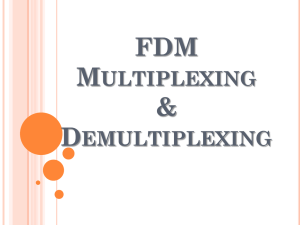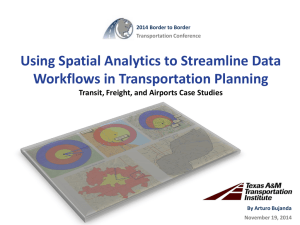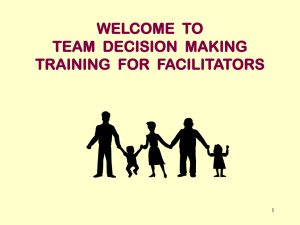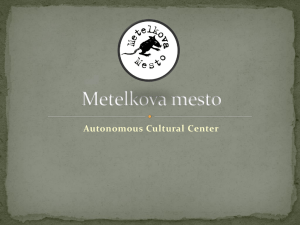TDM Strategies
advertisement
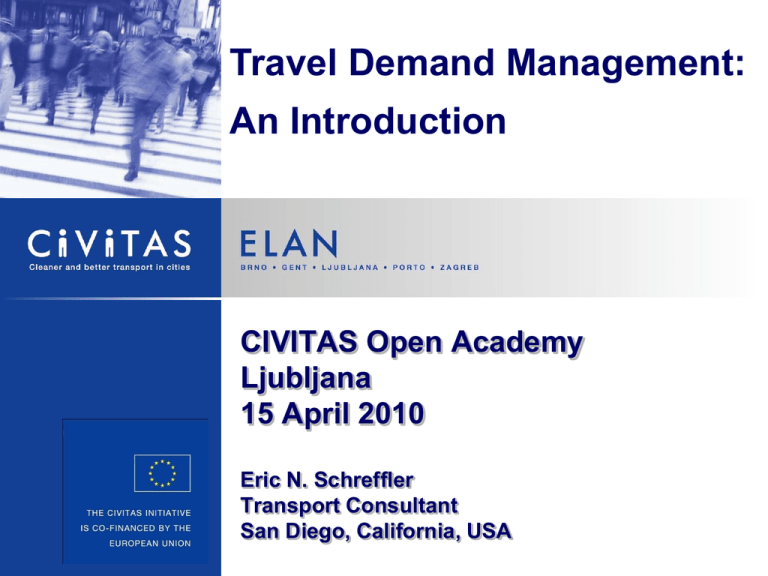
Travel Demand Management: An Introduction CIVITAS Open Academy Ljubljana 15 April 2010 Eric N. Schreffler Transport Consultant San Diego, California, USA Two Approaches Supply-oriented: predict need, supply infrastructure to meet travel demand Demand-oriented: influence the need to, timing of, and location of travel to reduce overall demand and make existing supply more efficient TDM Basics - Ljubljana Workshop Outline What is TDM? Why and how can we manage demand? TDM and infrastructure TDM cost effectiveness Final thoughts Source of more information TDM Basics - Ljubljana Workshop V/C Ratio – Volume/Capacity Predict and Provide Demand Management V – predict demand V – manage demand --- --- C – provide capacity C – maximize efficiency Assumes volume constant and adjusts capacity Assumes capacity constant and adjusts demand TDM Basics - Ljubljana Workshop DEFINITION: What is Travel Demand Management? The U.S. Department of Transportation, Federal Highway Administration defines TDM: Managing travel demand is about providing travelers, regardless of whether they drive alone, with travel choices, such as work location, route, time of travel and mode. In the broadest sense, “demand management is defined as providing travelers with effective choices to improve travel reliability.” Federal Highway Administration, 2006 TDM Basics - Ljubljana Workshop TRAVEL DEMAND vs. TRAFFIC MANAGEMENT TDM Basics - Ljubljana Workshop Other Definitions of TDM “balancing travel needs with the capacity of available facilities to efficiently handle this demand” or “application of strategies & policies to reduce automobile travel demand, or to redistribute this demand in space or in time””[ TDM Basics - Ljubljana Workshop DEFINITION: TDM City Perspective Any strategy, program, or combination of strategies and programs designed to change travel habits. Specifically, TDM projects attempt to reduce single occupant vehicle trips. (Greenfield, Massachusetts) The general term for strategies that result in more efficient use of transportation resources. (Burlington, Vermont) TDM Basics - Ljubljana Workshop TDM vs. Mobility Management Transportation Demand Management (TDM) tends to include a broad set of strategies that includes road pricing, facilities to encourage mode shift, and incentives to use them Mobility Management (MM) may be seen as a subset of TDM which includes measures such as information, marketing, partnerships, communications, and promotion of sustainable modes. “MM is soft measures to influence travel before it starts.” TDM Basics - Ljubljana Workshop Sustainable Urban Transport The European Union (Council of Ministers of Transport) defines a sustainable transportation system as one that… allows the basic access and development needs of individuals, companies and society to be met safely and in a manner consistent with human and ecosystem health, and promotes equity within and between successive generations. TDM Basics - Ljubljana Workshop Why Manage Demand? Cannot build our way out of congestion Negative impacts of car of environment It is much cheaper than new infrastructure It makes better use of existing system Makes road investment last longer People appreciate having choices People want a sustainable future TDM Basics - Ljubljana Workshop Categories of TDM Strategies Enhanced travel options New Public/Private Partnerships Financial Incentives and disincentives Real-time Traveler Information Access and parking management TDM Basics - Ljubljana Workshop TDM Strategies: A Sample Travel plans at worksites and schools Personalized travel planning and advice Carpool ride matching services Promotion of public transport services Offer of incentives to use sustainable modes Priority treatment of high-occupancy vehicles Managing parking and parking pricing TDM Basics - Ljubljana Workshop TDM Applications Schools & Universities Special Events Recreation & Tourism Destinations Transportation Corridor Planning & Construction Mitigation Employer-Based Commute Programs Airports Incidents & Emergencies Freight Transportation TDM Basics - Ljubljana Workshop Integration with Infrastructure TDM can influence demand before decision made to use car on highway Mode choice is only one response, time and route choice can influence efficiency of congested roads Preference can be given to high occupancy vehicles TDM strategies can be tested during construction activities TDM Basics - Ljubljana Workshop Integration TDM can be seen as part of daily management and operation of road system Traffic management centers can influence choices Incentives and disincentives can be offered to provide time advantages to higher occupant modes Focus is on traveler rather than on vehicle TDM Basics - Ljubljana Workshop Benefits of TDM TDM makes road system more efficient TDM is good for business TDM is a low-cost solution Effective TDM addresses many urban goals: • Congestion relief • Mobility enhancement • Air quality abatement • Energy conservation TDM Basics - Ljubljana Workshop Comparative Cost Effectiveness Los Angeles County Performance Monitoring Study Carpool program removed car from the roads for about $1 per day New tram line costs about $2.50 per day for each new rider (and not all from cars) TDM Basics - Ljubljana Workshop TDM Strategies and Emissions Comparative Cost Effectiveness (cost per pound of emissions reduced) Regional rideshare programs ............................................. Charges and fees ................................................................ Vanpool programs.............................................................. Miscellaneous TDM........................................................... Conventional fuel bus replacement.................................... Alternative fuel vehicles .................................................... Traffic signalization ........................................................ Employer trip reduction ................................................... Conventional transit service upgrades ............................. Park-and-ride lots (rideshare and transit)......................... Modal subsidies and vouchers ......................................... New transit capital systems/vehicles ............................... Bicycle and pedestrian programs ..................................... Shuttles and feeder buses …………....................................... Freeway/incident management ........................................ Alternative fuel buses ...................................................... TDM Basics - Ljubljana Workshop $3.70/lb. $5.15/lb. $5.25/lb. $6.25/lb. $8.05/lb. $8.09/lb. $10.05/lb. $11.35/lb. $12.30/lb. $21.50/lb. $23.30/lb. $33.20/lb. $42.05/lb. $43.75/lb. $51.20/lb. $63.20/lb. Final Thoughts TDM is not a cure-all; one tool in toolbox TDM involves packages of strategies designed to influence travel and travelers Individual strategies have finite impacts TDM most effective when integrated TDM is widely acknowledged as low-cost when compared to supply-side solutions TDM is becoming more of a philosophy than a set of strategies TDM Basics - Ljubljana Workshop ADDITIONAL INFORMATION U.S. Perspective on European TDM http://international.fhwa.dot.gov/traveldemand/index.cfm www.eltis.org TDM Encyclopedia WWW.VTPI.ORG/TDM TDM Basics - Ljubljana Workshop

